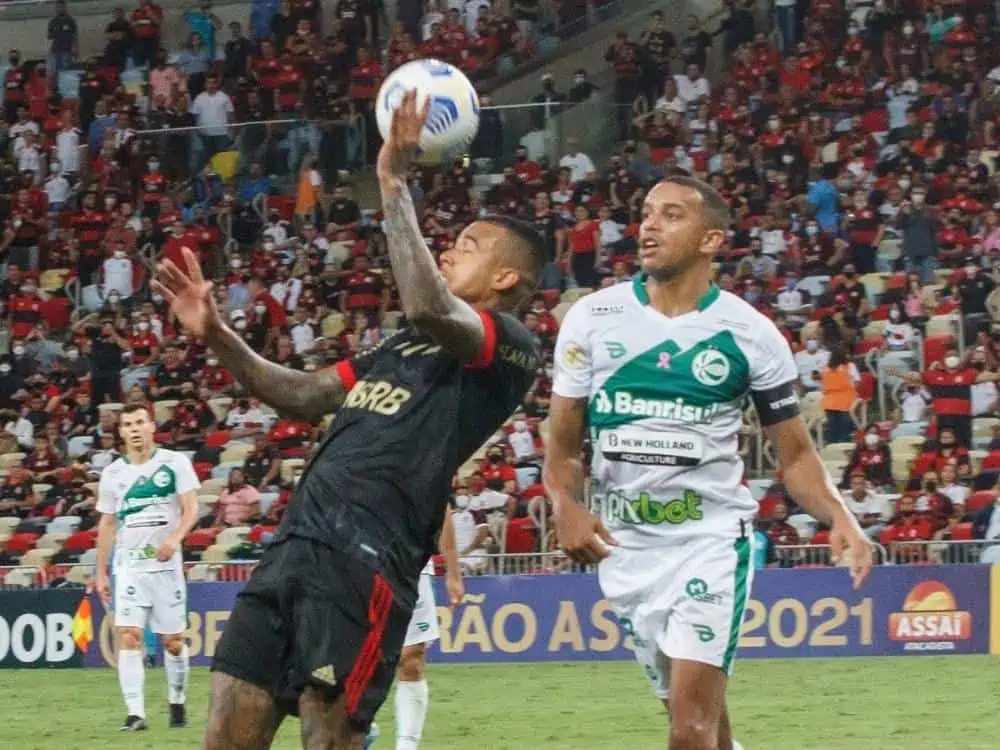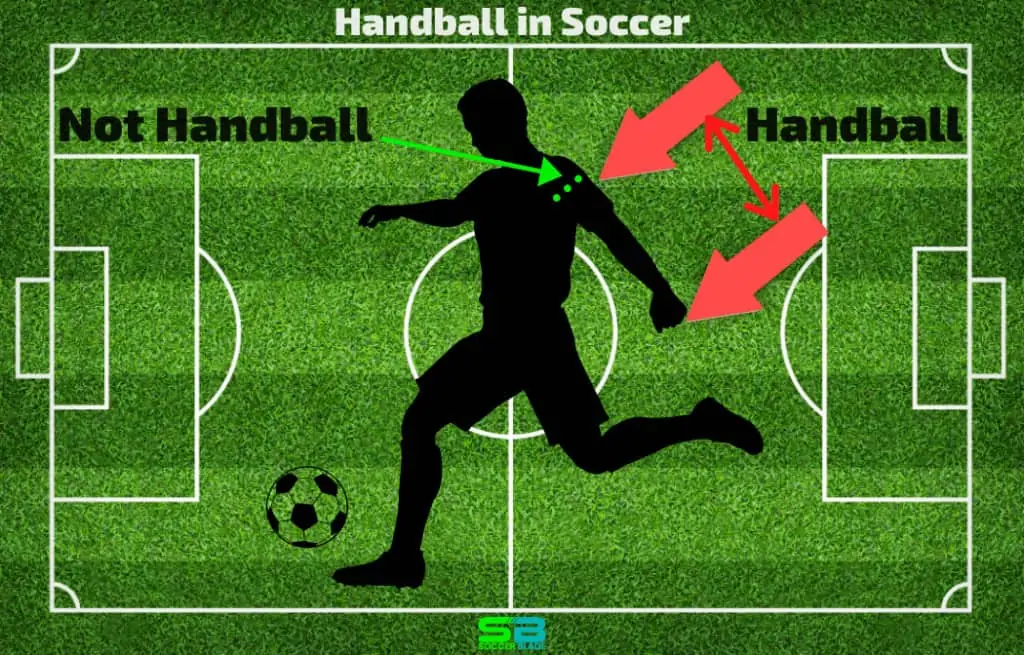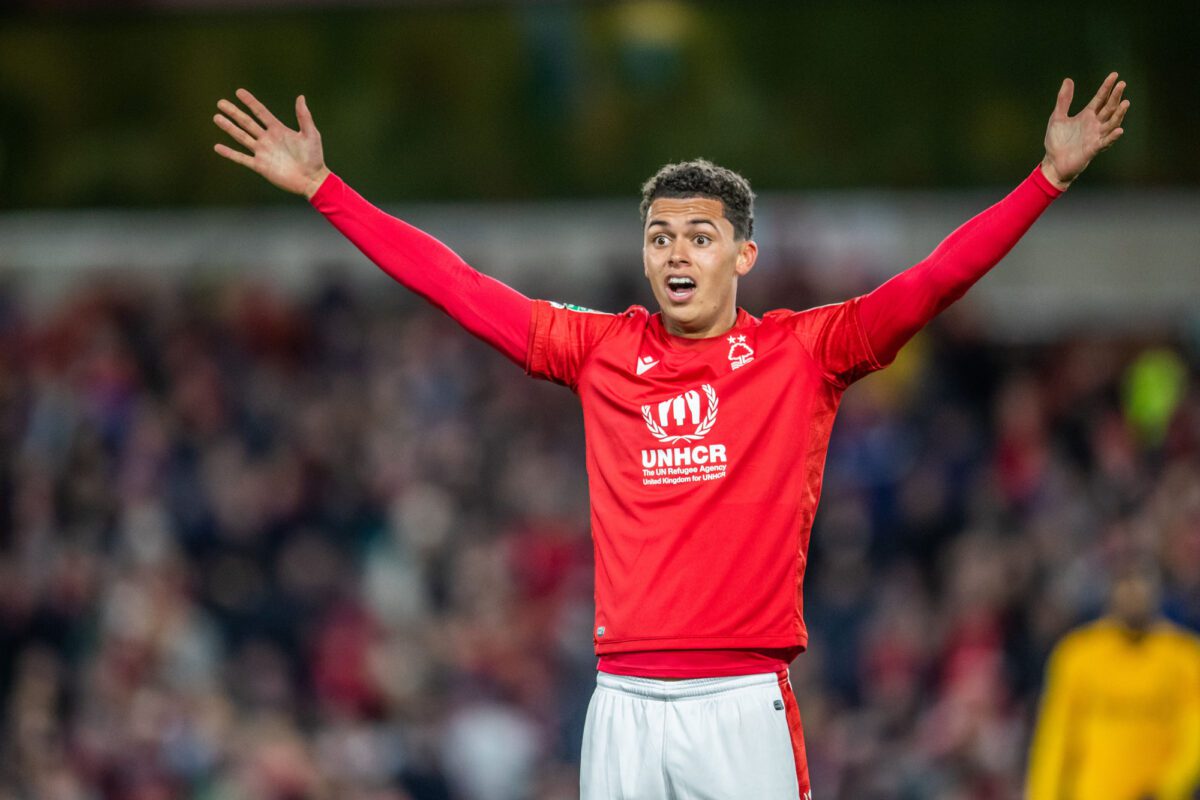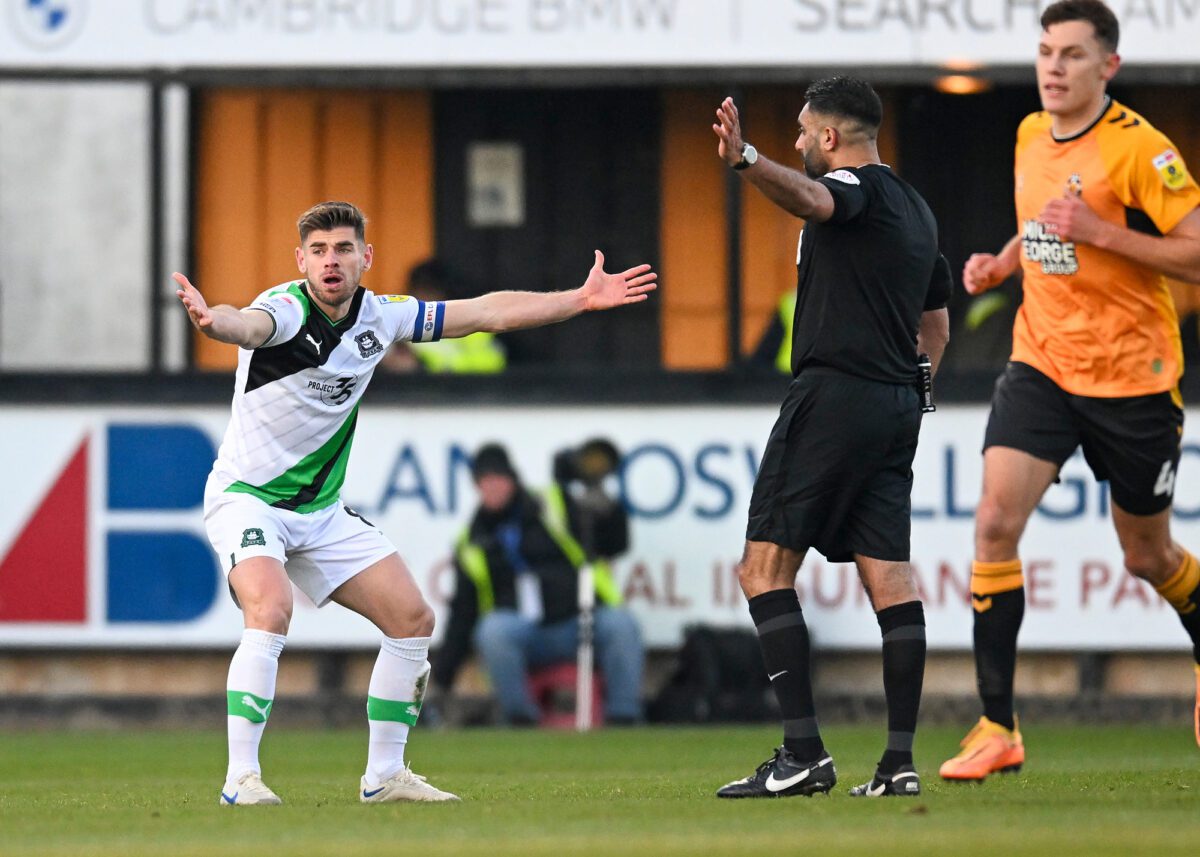Share the post "What is Handball in Soccer? (Rules + Situations)"
Handball is a core rule in the game of soccer. It distinguishes it from many other sports and is one of the biggest influencers on how the game is played.
This article covers all aspects of the handball situation that is important to know in soccer. We look at different situations, the laws of the game, and some real-game situations.

Is handball a foul in soccer?
If you handle the ball in soccer it’s a foul. A free kick or penalty is awarded to the opposition. The player that made the handball can be given a yellow or red card.
What is handball in soccer?
Handball is a foul by which a player’s hand or arm touches the ball. This area of the hand/arm is from under the shoulder to the tip of the finger. It’s legal to use the upper part of the shoulder to touch the ball.
However, as with many things in soccer, there is a lot more to the handball rule. There are a number of exceptions to the rule, as well as varying consequences and situations where the rule can be adapted.
Which part of the Arm is handball in soccer?
The image below shows you that you can use the upper part of the arm – the shoulder to touch the ball without it being a foul.
It’s up to the referee to decide if it’s a foul if the ball hits this area.
To get an understanding of where it is on your body. If you put a line from under your armpit, around your arm – this is safe you use without it being considered handball.

Although the shoulder area is of little use when trying to hit the ball. Brave defenders will use any legal part of their body to stop the opponent.
Is it a handball if it hits your leg first?
If the ball is moving at a fast pace and you are unable to move your arm/hand out of the way of the ball after it hits your leg, it’s not handball.
There are a couple of questions a referee thinks of before awarding the foul;
- Was the handball intentional?
- Did the player make the body bigger?
- Was an advantage gained from the handball?
These are the fundamental laws of handball in soccer.
Handball Rules Changes
The handball rule has endured several changes over the years, but its current form is the most important to consider.
In the modern era, handball has predominantly been viewed as intentional or unintentional; with the former being a definitive punishable offense, and the latter being a discretionary offense.
- The term “intentional” creates debate by its very nature, as it is impossible to state for sure what someone’s intentions truly are.
Therefore, IFAB (in 2019) created a list of exceptions and has given more specifics to the rule.
Handball in the build-up to a goal
From March 2021, if a player handballs in a build-up to a goal, the goal will be disallowed. The handball must be from a player that;
- Makes themselves bigger
- Handballs intentionally
The goal will be reviewed by the video assistant referee to decide if it gained an advantage.
This comes after some controversial goals gave – here is a video that explains the problem before this new rule;
The Official Yellow Card Ruling
The official IFAB (The International Footballing Association Board) ruling cannot be defined in a single line, there are many layers and variables. Let’s take a look.
Handball Situations – when is handball given?
Intentional/deliberate handballs are always punishable. The following handball circumstances, even if deemed unintentional, are punishable by a free-kick or penalty.
- The ball goes into the goal after touching an attacking player’s hand/arm
- A player gains control/possession of the ball after it has touched their hand/arm and then scores, creates a goal-scoring opportunity, or gains a significant advantage
- The ball touches a player’s hand/arm which has made their body appear unnaturally bigger. For example, a player extending their arm(s) widely
- The ball touches a player’s hand/arm when it is above their shoulder (unless the player has deliberately played the ball which then touches their hard/arm)
Non-Handball Situations
The situations below should not (usually) be penalized by a penalty/free-kick unless they are one of the situations from the above section
- The ball touches a player’s hand/arm directly from their own body (incl. Head, torso, foot), or the body of an opponent who is close to them
- The ball touches a player’s hand/arm that is near their body and has not appeared to make their silhouette unnaturally bigger
- If a player falls and the ball touches their hand/arm when it is supporting their body or breaking their fall
- If the goalkeeper touches the ball with their hand/arm outside of their penalty box. If a goalkeeper handles the ball inside their penalty box when not permitted to do so, an indirect free-kick will be awarded to their opposition
Note: GKs cannot handle the ball in the penalty box from a deliberate kick or throw-in from a teammate, or having released the ball from their hands.
There is a significant element of the referee’s discretion when deciding a handball or not. In recent times, VAR has been making major handball decisions in soccer.

Is it a handball if you’re protecting your face?
If your hands protect your face and the ball hits your hands, it’s not a handball. If your hands were not in front of your face, the ball would stop when it hit your face. So you are not gaining any advantage.
Be careful; if your hands protect your face, your arms can be pointing outwards. This could be seen as an unnatural position.
So when you think the ball will hit your face, it swerves and hits your arm – so be sure to tuck your arms into your body.

Handball Consequences
Different handball violations warrant different penalties. Most punishments for handball are at the discretion of the referee. However, there are some guidelines for specific incidents.
- A handball will not be penalized if it is an instance such as any of the scenarios mentioned above
- A standard handball foul during a game is generally punished with a free-kick or penalty being awarded
- A yellow card may be given to the handball culprit if the foul is deemed to be more cynical or a worse offense than a standard handball. However, this is at the discretion of the referee
- A red card is awarded for handball if the offense prevents a clear goalscoring opportunity. A player may also be given a red card if they receive a second yellow card for a handball
Here are some examples of handballs and how they are punished:
Red Card for handball
Luis Suarez received a straight red card for this deliberate handball which denied Ghana a goal at the 2010 World Cup. This incredible incident happened as the game was tied at 1-1 in the final minute of extra time.
Ghana went on to miss the resulting penalty and was eliminated from the competition in a penalty shootout.
Yellow Card handballs
Cristiano Ronaldo was judged to have deliberately handled the ball.
The referee, at his discretion, decided that it warranted a yellow card. In this case, it was Ronaldo’s second yellow, and he was sent off.
VAR: Video Assistant Referee
The wording of the handball rules was changed in 2019, coinciding with the introduction of VAR.
The wording of “intentional” and “unintentional” handballs was originally used to give the on-field referee some discretion and freedom to make a correct call on the field.
With the ability to go back and replay incidents through VAR, there is no longer room for such discretion. The handball rule has to be cut and dry.
VAR influence has led to more consistent handbell governing, but it has not come without controversy.
- Introduced for the Champions League knockout stages in 2019, VAR was called into play on several occasions regarding handball.
Some major ties were decided by VAR’s intrusion at the very late stages of games. Let’s take a look at two examples:
Paris Saint-Germain (PSG) vs Manchester United
In this instance, the referee originally awarded Manchester United a corner. After being alerted by VAR, the referee checked his sidelines monitor, overruled his original decision, and awarded a penalty kick.
Pascal Kimpembe (PSG) was adjudged to have positioned his body and hand/arms in “unnatural” positions when blocking the ball, subsequently committing a foul.
In any year before this, the penalty would not have been given.
Manchester United scored the injury-time penalty, eliminating PSG from the Champions League due to the away goals rule.
In the above video, we hear many different opinions about the decision and the handball rule, including the professional opinion of the referee.
In classic soccer fashion, there is little agreement in the discussion.
Manchester City vs Tottenham Hotspur – handball goal incident
This goal from Tottenham Hotspur’s Fernando Llorente was the tie-winning goal in their second-leg Champions League game against Manchester City.
The ball appears to have come off his arm before hitting the back of the net.
This goal was checked and awarded as legitimate by VAR as Llorente’s arm was judged to have been in a natural position.
The decision is reviewed and explained by a professional referee in the video below:
In both of these games, IFAB changed the wording of the rule (as shown earlier). The penalty from the Manchester United vs. PSG game still stands under the new wording.
However, Tottenham’s goal would not have stood if scored this season. Many viewed these handball decisions as unfair, harsh, or wrong.
With the ruleset being changed to more definitive laws, the soccer world is witnessing a more consistent global game.
Although they may disagree, players and fans alike are becoming accustomed to what is and isn’t a handball, as per the rulebook.
Handball and VAR
We are mid-way through the first season, where VAR and the current handball ruling are being used in the global soccer game.
Although controversy remains and debates on decisions and incidents amongst fans, pundits and players will always be part of the game. We are beginning to see consistency regarding handball decisions.
At the worst of times, consistency in decision-making is as much as we can ask for.
It will be interesting to see how IFAB and the major soccer organizations will feel following a largely experimental year about VAR and the game’s rules.
In the coming months and years, we may see further adjustments and tweaks to the handball rule and its officiation. For more useful guides, see the articles below or visit our home page.
Related Handball Questions
When is a penalty awarded in soccer?
A penalty is awarded in soccer when players commit a foul in their penalty box. This can be a tackle, push, nudge, handball, or any offense ruled by the referee.
Can a goalkeeper handle the ball outside the penalty box?
No. Once a goalkeeper has left their penalty box, they operate under the same handball ruleset as any other outfield player. Interestingly, a goalkeeper was allowed to handle the ball outside the penalty box before 1912!
Can a goalkeeper get a red card for handball?
Yes. If a goalkeeper is deemed to have prevented a goalscoring chance due to handball, they can be red-carded. They may also get a red card if they receive a second yellow card for handball.
Share the post "What is Handball in Soccer? (Rules + Situations)"
Joel is a seasoned soccer journalist and analyst with many years of experience in the field. Joel specializes in game analysis, player profiles, transfer news, and has a keen eye for the tactical nuances of the game. He played at various levels in the game and coached teams - he is happy to share his insight with you.



